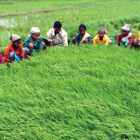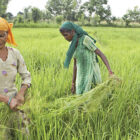The illusion the “good days are coming” will not last long if the current regime opts for a free-fall towards a free market economy rather than structured liberalisation.
Raghuram Rajan determines the monetary policy of India from the 18th floor of the Reserve Bank of India (RBI) headquarters in Mumbai. The view from there is as breathtaking as his grasp of the macro economy. A discussion with him leaves one reassured that the country is in good hands. For one, Rajan has the patience to listen and discuss a topic threadbare; a trait that the finance ministry bureaucrats at North Block would do well to cultivate. India’s new finance minister, met specialists from various sectors, including agriculture experts but the ministry did not ask the agriculture ministry for names of farmer organisations to call. It chose to call the ‘convenient’ groups, a practice followed by the erstwhile United Progressive Alliance (UPA) government too.
Raghuram Rajan’s counterpart in the United States of America, the chair of the Board of Governors of the Federal Reserve System, Janet Yellen, has more influence on policy in the USA than Raghuram Rajan has in India. Rajan, however, completely understands that the RBI’s tinkering with repo rate, interest rates, gold imports restrictions and such other such measures will not suffice for the purpose of reigning in inflation in the long run. These are passé and the canvas for effective action should be much wider. There was thus a meeting of minds on the issue of supply side of food inflation; supply, not from the farm but from the farm to the consumer. One presumes that the RBI governors before him have never bothered to call farmers for consultations and this change has been greatly appreciated.
The Congress Party-led UPA was decimated in the elections in spite of several years of good monsoon and rising agricultural production because it chose to listen to a band of people without the necessary bandwidth, without realising that rising agriculture production is as different from farmer profitability as agriculture economists are from farmers. Indian farmers are ready to learn from economists. However, they would rather not have economists advocate policy for them. Having suffered from years of misguided left-wing policies thrust on them by non-state players (read, the National Advisory Council), farmers are now worried that the new regime may shift to a farming policy dictated by business houses and right-wing economists.
Everyone is worried about food inflation. Reducing it is a tall order because, at the farm level, most food prices are already very low and the threat of a weak monsoon looms large this year. The farmer is worried that gram (chickpea) is selling today at the same price as it was in 2006. Mustard and barley prices are the same as in 2008. These are non-perishables under the government-administered minimum support price umbrella. Even the minimum support price in this drought year has not increased substantially for paddy. For bajra, maize, groundnut and soyabean, it has not been increased at all.
Of immediate concern are the farmers’ anxieties about the government’s response to the uproar over inflation; a key issue on which the UPA floundered. Some economists have suggested reducing import duties on fresh fruit and vegetables, which will squeeze producer margins. In what is a short-sighted step, potato and onion trade has been restricted in a bid to rein in the spiralling prices. These actions of the government may not only lead to a doubling of prices of these produce after four months but also continue the legacy of misunderstanding ground realities.
The much-maligned vegetables tell a sad story. Last year, farmers sold green pepper at ₹12 per kg. Today they are compelled to do a distress sale at ₹2, even though the cost of picking the peppers is ₹2. Add to that the cost of transport and other commissions. The irony is that even though the green pepper price has fallen by 600 per cent in one year on the farm, the street price remains the same at ₹60 per kg.
Tomato processing is the much-trumpeted success story of the food-processing sector. Last year, farmers sold tomatoes for ₹10 per kg. Today they fetch only ₹2 per kg. Bharat Krishak Samaj farmers offered to give their tomato crop for free if prospective freeloaders would harvest, load and undertake the transportation themselves. At a personal level, one has offered such terms on the micro-blogging service Twitter and found no takers. So much for social media marketing. Even something that is free has a price. The same free tomatoes were being bought by consumers at ₹15 per kg in the market; at a 750 per cent margin. The distress is mind-boggling. The crisis for the subsistence farmer is existential.
Another apprehension among farmers is fuelled by rumours about the new government’s policies for curtailing or abolishing the fertiliser subsidy to balance the fiscal deficit. No farmer would object to a subsidy curtailment if there is a corresponding increase in his real income. As of now though, the increased price of fertilisers will not translate into a higher price realisation for the farmer, thereby increasing losses. The illusion that “good days are coming” will not last long if the current regime opts for a free-fall towards a free market economy rather than structured liberalisation. One would like to believe that the Bharatiya Janata Party (BJP) will not fall prey to “educated” articulation. Is that faith misplaced?




